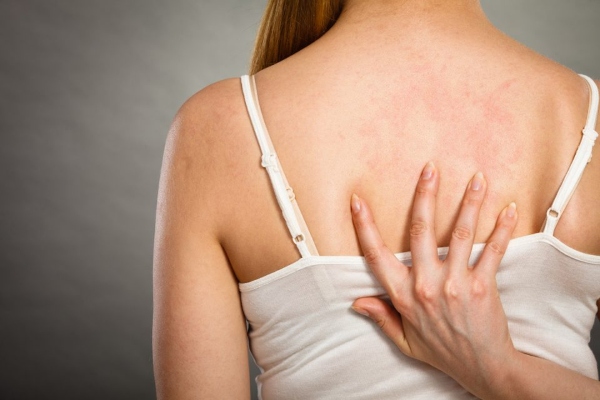What Is Urticaria?
Urticaria is more commonly known as “hives”. Hives are raised, red- or skin-colored wheals (welts) on the skin with clearly defined edges. They are usually itchy and often an allergic reaction to medicine or food. This is known as allergic urticaria. Although they usually occur as an allergic reaction, hives are very common and anyone can get them. They can appear on the back, arms, legs, and face.

Hives can change shape or vanish and reappear in a matter of minutes or hours. The hives may get larger, multiply, and connect to form bigger areas of flat, raised skin. If you put pressure on the center of a hive, it will turn white – this is called blanching. Hives can be uncomfortable but are usually not a life-threatening condition. However, if you experience hives with a fever or if they are accompanied by difficulty breathing or swelling of your tongue or throat, you should contact emergency medical personnel immediately.
Types Of Hives
Angioedema
Angioedema is when welts or swelling occurs in the region of the face, particularly near the eyes and lips. Swelling from angioedema can also take place around your feet, hands, and throat. This happens when fluid accumulates. It is normally an allergic reaction, but it can also be hereditary.
Acute Urticaria
Acute urticaria is hives that last less than six weeks. Usually, the cause can be traced back to foods (nuts, milk, berries, eggs, tomatoes, fish, and chocolate), medications, infection, insect bites, or another illness. Sunlight, cold, and pressure can also cause hives. Hives caused by foods can materialize within minutes of ingestion or up to two hours later. Fresh foods cause hives more frequently than cooked. It is helpful for your allergy specialist to have a record of all food and drinks you consumed in 24 hours before you experienced hives.
Chronic Urticaria
Chronic urticaria lasts more than six weeks, and it is very difficult to identify its cause. Though rare, it may be a sign of a serious internal disease. That’s why it’s important to seek medical treatment if you experience chronic hives. The allergists at NY Allergy & Sinus Centers specialize in diagnosing and treating allergic skin conditions like hives.
Dermatographia
Dermatographia is a form of hives that occurs after the skin has been stroked or scratched. It is also known as skin writing. Symptoms usually don’t last very long. Individuals who experience dermatographia are otherwise healthy individuals.
Hives Diagnosis
Since most hives are caused by allergies, many physicians perform an allergy test to determine the exact substance causing your hives. A comprehensive medical history and a thorough examination are required for the appropriate management of symptoms. Hives can be prevented by avoiding irritants that have caused you to have hives in the past. You should also avoid taking hot showers or baths or wearing tight-fitting clothing after an episode of hives – they can cause your hives to return.
For non-allergy related hives, a diagnosis is harder to reach. In this case, your doctor may review your medical and family history. They may also ask you to complete a daily journal of activities to determine when your hives are triggered. Certain activities like exercising may cause hives.
Hives Treatment
Hives usually resolve on their own, but topical steroids and anti-itch creams help soothe symptoms. Treatment for hives also includes eliminating the triggers that cause them. Consult with our allergists to determine the best treatment plan for your symptoms. The allergists at NY Allergy & Sinus Centers are here to help you get relief from hives.
If you would like us to evaluate your hives, the allergists and specialists at NY Allergy & Sinus Centers would like to help. We can also help find relief for your asthma, nasal and sinus problems, ENT (ear, nose, and throat) symptoms, skin conditions, and food & respiratory allergies. We have access to the latest treatments and testing, and we offer convenient clinics throughout the NYC metropolitan area: drug-allergies-and-allergic-reaction-to-medication.php. For help, call us at 212-686-4448. We see adults and pediatric patients (children) from all around NYC, including Manhattan, Brooklyn, Queens, Staten Island, and the Bronx.
Urticaria (Hives) Frequently Asked Questions
Are Hives Contagious?
Hives are not contagious. You won’t develop them on your skin by touching hives on another perso
Can Hives Be Caused By Heat?
Hives can actually be caused by heat. In a condition known as photosensitivity, sunlight can trigger hives. Also, if your body temperature elevates after rigorous activity, you may experience hives.
How Long Does It Take For Hives To Go Away?
Hives can last anywhere from a few minutes to a few months. Usually, eruptions may last for a few minutes, sometimes several hours, and even several weeks to months. Most individual’s hives last no more than 24 hours.
What Causes Hives?
The most common causes of hives are certain foods and medications. Foods that trigger hives are nuts, chocolate, fish, tomatoes, eggs, fresh berries, and milk. Medications like antibiotics (especially penicillins and sulfa drugs), NSAIDs, and anti-seizure drugs are the most common drugs to cause hives.
When Should I Go To The Doctor For Hives?
You should see a doctor if your hives outbreak doesn’t disappear in a few days. Also, if you notice symptoms of angioedema or anaphylaxis, call 911.
Why Do Hives Get Worse At Night?
Hives can worsen at night due to dust mites or the temperature of your home. Some individuals get hives in cold temperatures from the air conditioning.
